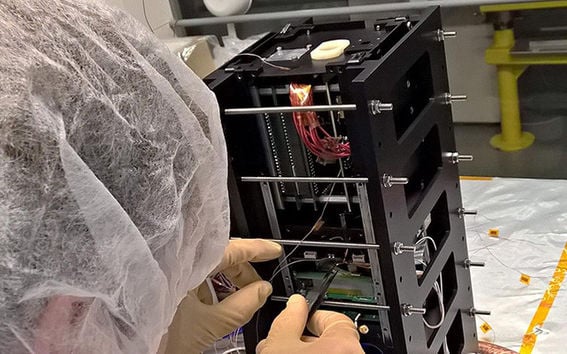Aalto-1 reaching great heights

'We are waiting for the last parts of Aalto-1 to arrive to be finished in Otaniemi,' notes Antti Kestilä, System Engineer and doctoral student.
The students have spent the summer working on the project on the Otaniemi campus. Every now and then they have visited at least the magnetic test laboratory in the observatory of the Finnish Meteorological Institute in Nurmijärvi and conducted vacuum chamber tests in the laboratory facilities of the Technical Research Centre of Finland (VTT).
'We conducted the last big and important test on the satellite test model in July when Aalto-1 spent a week in a thermal vacuum chamber in the VTT laboratory facilities,' says Antti.
In the thermal vacuum chamber, the operation of the satellite's test model was being tested in the temperatures and pressure that prevail in space. The differences in temperature inside the satellite varied between +50 and -10 degrees centigrade.
'The test was like a simulation of what is to be expected in space. The changes in temperature, as we say, on the sunny side and in the shade, are very big, and our intention was to verify that the satellite's systems would tolerate the conditions in the orbit. The result of the test was exactly what we were hoping for, in other words apart from small defects everything was functioning as it should be,' confirms Tuomas Tikka, Quality Manager and doctoral candidate.
From a test model to a flight model
Several versions of the Aalto-1 nanosatellite have been made, the majority of which have been kept in Otaniemi. The first version was built of cardboard by the students five years ago. The last version tested has been built so that its systems are as similar as possible to the final flight model that will be launched to space.
'Over the years, a large amount of documentation has been generated as a result of building different systems. However, in the end the flight model will be assembled with help of a 49-page assembly guide, which in practice resembles assembly instructions for furniture,' Antti describes the start of the final assembly phase.
In the next few weeks, once the last parts have arrived in Otaniemi, the flight model will reach its full height, slightly taller than a milk carton, within a fairly short time frame. The final satellite that will be launched into space will still spend some time in vibration and vacuum chamber verification tests, but they will not be as extensive as previously.
You can follow the assembly process of the flight model on Twitter twitter.com/aaltoone and on Facebook facebook.com/AaltoSatellites
Aalto-1 is a student satellite project spearheaded by the Department of Radio Science and Engineering of the Aalto University School of Electrical Engineering. Aalto-1 will take important Finnish space expertise into space for testing. A new type of spectrometer device developed by VTT will be used for remote environmental sensing, while a radiation meter built by students from the University of Helsinki and University of Turku will take radiation measurements. Aalto-1 will also test an electrostatic plasma brake for deorbiting satellites that was designed by the Finnish Meteorological Institute.
Read more news

Get to know us: Associate Professor Maria Sammalkorpi
Sammalkorpi received her doctorate from Helsinki University of Technology 2004. After her defence, she has worked as a researcher at the Universities of Princeton, Yale and Aalto.
Aalto computer scientists in ICML 2024
Computer scientists in ICML 2024
Getting bacteria into line
Physicists use magnetic fields to manipulate bacterial behaviour